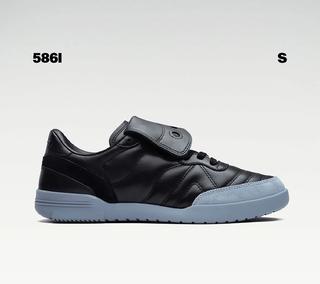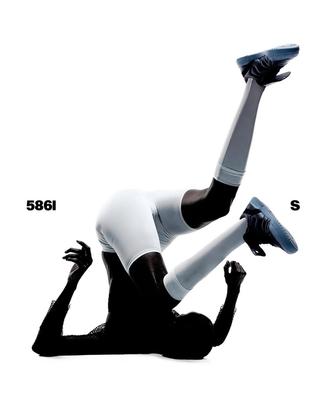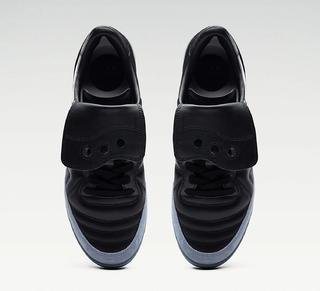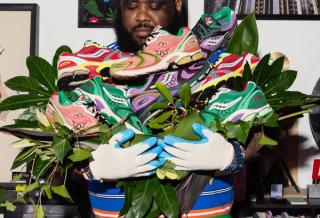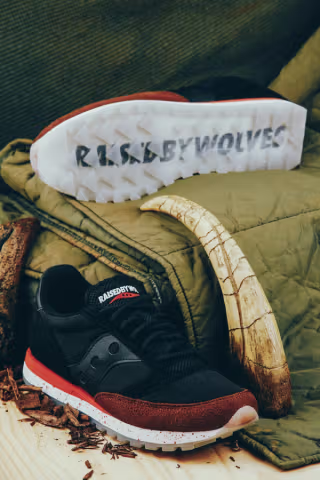Saucony is the original running brand. Since its founding in 1898, the North American company has developed high-quality product and initiatives rooted in three principles: good performance, good health, and good community. And while the Boston-based institution continues to prioritize running, it's also gone into the archives to celebrate its past in other sports. The 586csi football trainer from 1987 is the latest bring-back—courtesy of the brand's SILO arm.
Spearheaded by Paul Ruffles, Brand Director for the experimental Merrell 1 TRL, Saucony SILO was revealed to close associates of the century-old company during January's Paris Fashion Week. Touted as "a new dimension of the Saucony lineage," Ruffles' work looks to the past to innovate for the present day and future. Everything from its art direction to the silhouettes it utilizes as canvases showcases an elevated, avant-garde-like perspective that allows Saucony to exist in a refreshing space.

Ruffles and team seem primarily focused on expanding the North American company's lifestyle arm, but their first project to release to the public was the Endorphin Elite 2. As Saucony's marquee marathon racer, the silhouette delivers cutting-edge performance in a package that pushes design into the next 100 years.
Saucony SILO's inaugural showcase displayed faithful reissues of the ProGrid Guide 7 and original Kinarva, performance-running models from throughout the 2000s. Additionally, Ruffles' experimental project has returned to the '80s for retros from other sports needs.
The 586csi is a widely-forgotten piece of Saucony's catalog for the beautiful game. A thorough Google search for the silhouette brings up little-to-no results, with the clearest piece of history deriving from an Instagram account that chronicles obscure Saucony footwear.

Presumably inspired by the era's Coupe Sport, fuel-injected BMW vehicles, the Saucony 586csi delivered the same high-quality standards found across the brand's running models.
A premium leather build across the upper was reinforced with soft suede at the tip of the toe and lower heel. The Saucony Creek-inspired logo at the profiles also opted for a fabric construction. Model-specific branding was stamped into the lateral heel, with cupsole-reminiscent tooling rounding out the package. Specific numbers of how many 586csi pairs were sold aren't available on the internet, but Saucony's offering had to face stiff competition within the world of leather football trainers for indoor and turf field use.
SILO's re-imagination of the 38-year-old design skews towards the fashionable, although its construction seems sturdy enough to hold its own on the court. Clear teaser shots shared to the initiative's Instagram account showcase a supple leather build with the same quilting across the upper that appeared on the shoe's original run. Logos at the profiles, however, have taken on a minimal aesthetic that aligns with the project's overall creative direction. A suede panel wraps around the forefoot, blending in with the reworked tooling's light blue color scheme. A long, fold-over tongue brandishes the three boulder-inspired circles rooted in Saucony's guiding principles, firmly positioning the 586i in the current old school football trend.
House of Heatº emailed with Ruffles after this story went live. Here is the exchange, which has been edited for clarity.
House of Heatº: How difficult was it (if at all) to convince Saucony to reissue a long-forgotten piece of its footwear catalog?
Paul Ruffles: Not at all. The 586i S is an integral part of the Saucony SILO range, which is an exploratory place for the brand where we are looking to recontextulaize Saucony for now and the future. It's not about nostalgia—it's about celebrating and progressing the very best and unique parts of the brand in a very considered and elevated way.
Had there been plans to push the 586i prior to SILO? (At quick glance, the 586i is a fairly faithful reissue of the original from the late 1980s.)
While building the range's architecture, there was always an idea to feature something different from running. Obviously, Saucony is well respected and loved in this sport, but, over the years, they've also made some great footwear in other areas (umpire shoes being a favorite niche of mine). These are all an important part of the brand's history. The 586i S is not a one-to-one bring-back. As I mentioned before, SILO is not about nostalgia (there is enough of that out there). This is about recognizing the best elements and re-contextualizing them for today. What we did with 586i S is a good example of this.
How was the rebuilding process, and what are the major differences on SILO’s version?
We started with the original shoe and looked at how we could take the best parts of that—the shape, design language—and elevate it uniquely for today, while still making its football heritage clear.
We reviewed every part and retained what we liked; adjusted what we saw fit, removing unnecessary details; and added subtle, premium touches. We adapted the sole to make it cleaner and one piece, upscaled the material package, simplified design lines overall, added leather lining and OrthoLite® footbeds for enchanged comfort and even went several rounds getting the amount of the raised leather texture between the stitch lines right (they loved me for that).
The biggest change and potential risk were the tongue and logo. Part of the Saucony SILO ethos is to explore and create simple beauty with unique view points, and what we did embodied this thought process. We added a removable fold-over tongue that wasn’t on the original 586csi, but was a clear reference to football boots from back then. We then removed the classic logo from the side of the shoe to create a simple, clean look. We obviously wanted to retain a logo's presence so the “unique view point” was adding it to tongue, not printed, but cut and shaped into the leather so you see the logo when you look down at your shoes.
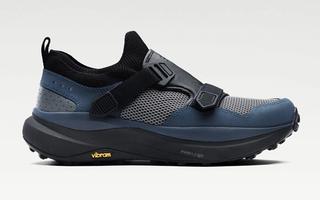
Ruffles also shared that the inaugural Saucony SILO range aimed to showcase a history of the brand's running legacy. The 1970s through the modern day is captured by the Gripper S, Grid X Ultra S, Kinarva 1 S, and Endorphin Elite 2 S.
The 586i S is expected in a number of color makeups—including white-and-orange and predominantly-blue with black-colored accents. Pairs without the fold-over tongue will also release via the Saucony Originals branch—the imprint that houses the Jae Tips partnership.
The reworked Saucony 586i by SILO has been confirmed as launching on Thursday, April 17, alongside other footwear by the experimental division.
For more sneaker news, check out the Tom Sachs Mars Yard 3.0, the controversial artist's first collaboration with Nike in two years.
